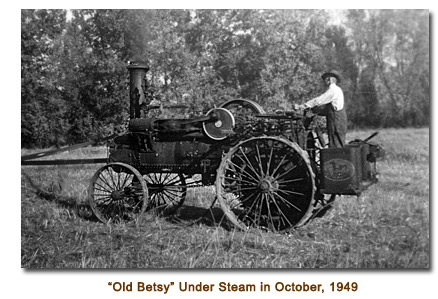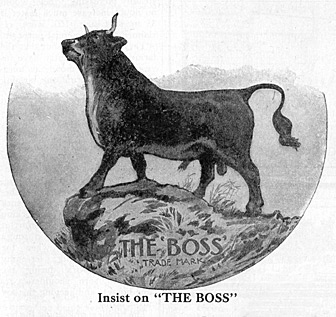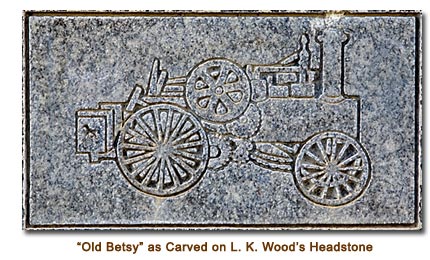Just Fifty Years Ago Today—
Just fifty years ago today (January 23rd, 1942) since Engine Number 6672, a 7-1/4" x 10" traction, on Boiler Number 6521 was run off the erection floor and pronounced completed under the able supervision of George Kinne, the foreman of that erecting crew of Russell & Company Builders, Massillon, Ohio, after which the ten horsepower was given the rigid test and inspection under Engine Inspector Thomas Murray.
In the rush for steam traction engines for the threshing season of the 1890’s, every facility was utilized and ten engines a week was the output — an increase over the previous time of six. But “old Betsy” (as she was christened soon after her purchase, named for a famous pulling horses belonging to an early settler) was not slighted or skimped in the rush to keep up production, as she has proved by her fifty years of service, and still runs as smoothly as a brand new auto.
She has all the essential features that later traction engines had, and no radical changes have been made, including Giddings patent clutch, double ported valve, spring mounted and trimmed with the famous Pickering Governor, Buckeye Whistle and Penberthy Injector, as well as provisions to use steam expansively.
The following spring, on May 9, Old Betsy was loaded on a flat car with other Russell products, and was soon wending her way across the Ohio hills, by Michigan Lakes and over the prairies of the noted corn states, from there to the Rocky Mountains, where an extra locomotive of the Gay 90 type was found necessary to haul the train over the Great Divide. She finally reached her destination and place of consignment, Salt Lake City, where the branch carrying the Russell line was known as the Consolidated Wagon and Machine Company. From there the latest type of steam power was sent to the Northern territory of the same implement company at Logan, Utah.
 A few months later, during the busy harvest season of August, the proud purchasers, Richards & Sanders, had Number 6672 all steamed up and headed for the quiet frontier village of Mendon. Some of the young townsmen, in anticipation of its arrival, rode horseback to meet it. Others awaited at the roadside anxiously for its approach. The sky was clear prior to the Indian Summer, and volumes of black smoke were hurled in the air, obliterating the morning sun as the ingenious monster wended its way westward toward the towering peaks of the western range at the base of which the little village of Mendon just ten miles west of Logan, had been undisturbed for generations with modern improvements except the Utah Northern narrow gauge railway over which the regular mixed train with its little locomotive made its regular runs. The marvel and wonder of such transportation was still commented on by the sturdy pioneers and contrasted to the previous traveling by ox team.
A few months later, during the busy harvest season of August, the proud purchasers, Richards & Sanders, had Number 6672 all steamed up and headed for the quiet frontier village of Mendon. Some of the young townsmen, in anticipation of its arrival, rode horseback to meet it. Others awaited at the roadside anxiously for its approach. The sky was clear prior to the Indian Summer, and volumes of black smoke were hurled in the air, obliterating the morning sun as the ingenious monster wended its way westward toward the towering peaks of the western range at the base of which the little village of Mendon just ten miles west of Logan, had been undisturbed for generations with modern improvements except the Utah Northern narrow gauge railway over which the regular mixed train with its little locomotive made its regular runs. The marvel and wonder of such transportation was still commented on by the sturdy pioneers and contrasted to the previous traveling by ox team.
Now that the threshing was going to be done by steam power, little wonder that general excitement existed in the village and some of the good folks wondered what the world was coming to. The shrill blast from the Buckeye Whistle announced the approach of the new steamer with its Tuscan red and black, golden glow and the shiny brass trimmings. It was indeed an imposing sight and even the ladies lowered their parasols to get a better view of the promised labor saving device that would hurry up the threshing so fewer meals would have to be served. As the little Russell ten horsepower was driven through the main thoroughfare with crowds on both sides of the street, waving hats and shouting swelled the pride of its English engineer as he majestically handled the levers under perfect control.
She was soon belted to the old Advance, which had proven a horse killer and the way she turned those wheels and ate grain without a sign of fatigue aroused praise from even the most skeptical, while some predicted an explosion and kept their distance. Others said such a complicated contraption wouldn’t last long, and the sorrels and grays would have to go back in the collar.
But old Betsy lived on and made her regular run each fall over mountains and rugged places where only a coyote or Indian previously roamed. Five different separators have passed on like the original owners and operators and gone the way of Mother Earth. The inspector, Mr. Thomas Murray has passed on. All the Russell Brothers have long since gone to reap their eternal reward. But Mr. George Kinne is still living in Washington State. The old shop foreman who also had a hand in the construction of Old Betsy is likewise among the living. Mr. Gassigues in his nineties delights to tell of those good old industrial days.
I have kept this marvelous engine in tune and ready to respond under the gentle touch of lever with the same realism and rhythm that only a Russell can produce. Recently I gave her a fresh coat of paint. Strange as it may seem, after removing the hardened grease, the original paint was bright and I had no trouble getting the proper color scheme.
Old Betsy has been retired from threshing and like a dignified Civil War veteran is used in parades and rare occasions. However she has her regular annual wood sawing jobs as well as grinding grain. “Better to wear out than rust out.” She now peacefully reposes under the old elm tree anxiously awaiting the spring thaws when she will again be resuscitated and her familiar sounds of exhaust and odor of burning oils and smokes will be heard in our peaceful village.
